PREVIEW: No. 19 Men's Hockey to Begin 2019-2020 Season
The Bright-Landry Hockey Center is on the eve of its annual winter-time festivities, as No. 19 Harvard opens the season at home against Dartmouth on Friday.
Friday marks the end of a difficult waiting period for a select few college hockey teams. While the rest of the NCAA eagerly kicked off the schedule in mid-October, six Ivy League squads looked on from afar. Only this weekend do these storied colleges embark on their 2019-2020 campaigns.
In Cambridge, the Bright-Landry Hockey Center is on the eve of its annual winter-time festivities, as No. 19 Harvard opens the season at home against Dartmouth on Friday.
“It feels like we’ve been practicing forever,” Crimson coach Ted Donato ’91 said. “I think the guys are excited to get started and be part of the college hockey party, if you will, that has already started.”
Before the Crimson commences its five-month marathon, here is a look back at the recent campaign and a glimpse into the season ahead.
BACK TO THE DANCE
Last season, the Crimson returned to the NCAA Tournament after 2017-2018 marked its only hiatus from national postseason contention in the past half-decade. A talented freshman class assimilated quickly to college hockey and helped the program establish an identity in the era following Ryan Donato’s early departure for the National Hockey League. The former standout — also the eldest son of the Harvard bench boss — commanded a great deal of attention as the team’s offensive centerpiece during his final collegiate campaign. So, his absence heading into 2018-2019 required that the Crimson reinvent its offensive approach and replace Donato’s production.
And the group was up to the challenge. Harvard rode timely goaltending, the country’s second-best powerplay (28.3%), a precocious young core, and one of the nation’s elite defensemen in Adam Fox (9–39—48) en route to a 19-11-3 record (13-7-2 ECAC), a four-win improvement over the prior season.
After a lackluster start to the year, the team had to earn its way back into the national rankings, from which it dropped in November 2017. For the first time in nearly eight decades, the team opened its schedule without a win through four regular-season games. While the Crimson had no problem scoring, team defense needed improvement.
Luckily for coach Donato’s group, by mid-November goaltender Michael Lackey ’19 (14-8-3, 2.34 GAA, .918 SV%) found his groove and propelled Harvard to some of its most impressive victories of the season: a Thanksgiving-weekend win over then-No. 15 Cornell — at Madison Square Garden, no less — and a mid-January triumph against then-No. 6 Quinnipiac.
After its victory in Manhattan, the Crimson battled to a top-10 winning percentage nationwide (.660) for the rest of the season. Harvard earned a first-round bye in the ECAC playoffs before sweeping Dartmouth in a quarterfinal series, only to bow out to a ranked Clarkson squad in the conference semifinals.
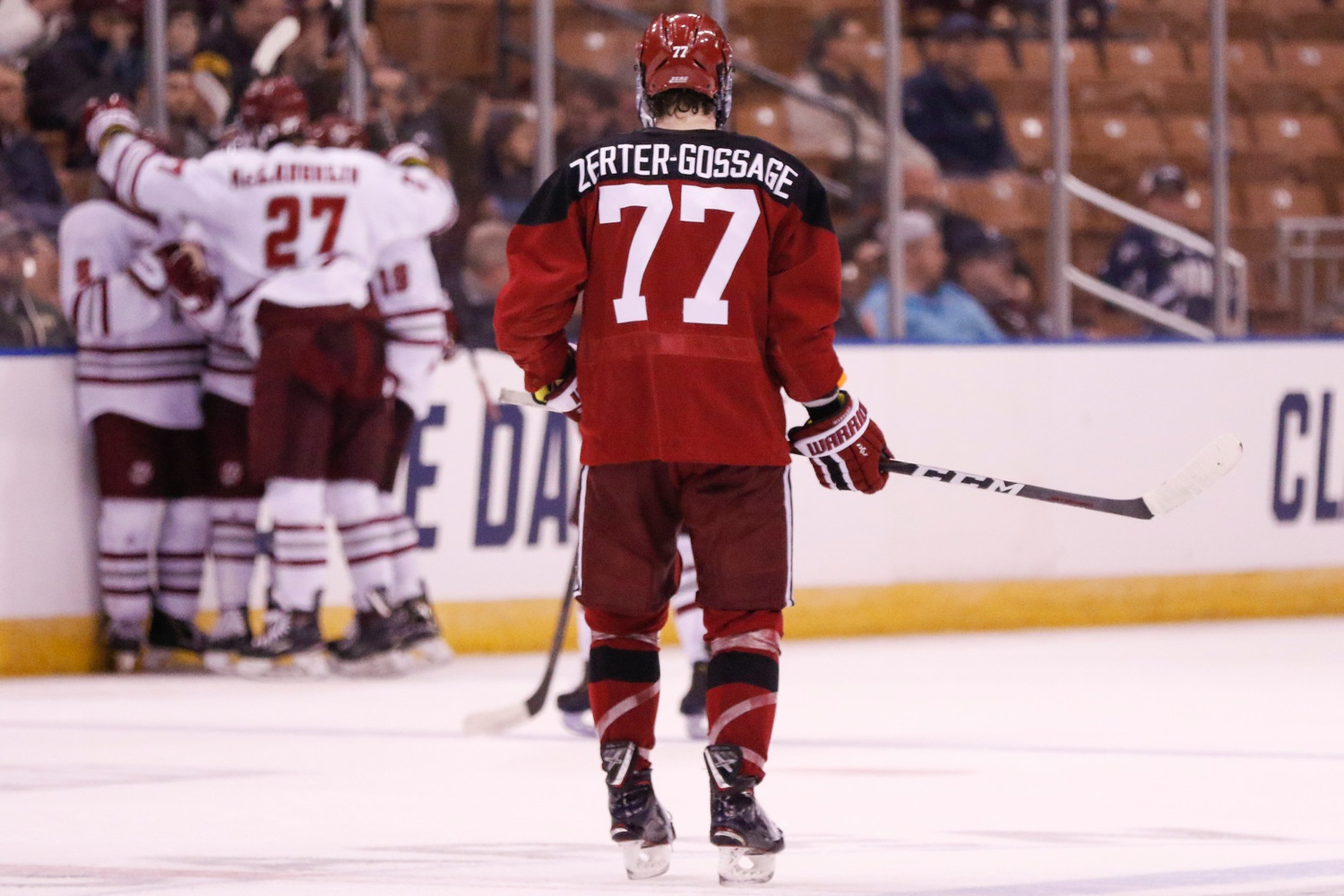
Despite the loss, the Crimson became just the third program in the last decade to reach the ECAC semifinals in five consecutive seasons. More importantly, the defeat did not cost the team a bid to the NCAA Tournament: Harvard’s Pairwise ranking earned it a No. 4 seed in the Northeast Regional of the national bracket.
The Crimson’s run ended there, however, as one-seed Massachusetts knocked off its in-state foe in the round of 16. But overall, last season successfully reinstated Harvard’s place in the national conversation and provided key takeaways off of which a young team will look to build this year.
“A big thing that we kind of got up and down with was just consistency, and maturity, too,” junior defenseman Reilly Walsh said. “It’s very important to regain control of the locker room. That’s going to be very important with a young group, understanding that we’re going to be down in some games…. Limiting our skids and inconsistencies is going to be very important.”
THE DEPARTED
The loss of key players to graduation is a reality for any college hockey program. The good ones find a way to replenish previous talent, as the Crimson did last year. Nevertheless, the team surely will feel the voids left by former co-captains Lewis Zerter-Gossage ’19 and Michael Floodstrand ’19, as well as ex-backstop Lackey. Harvard also watched its bottom defensive pair, comprised of Jacob Olson ’19 and Adam Baughman ’19, walk the stage after last season.
Zerter-Gossage is cutting his teeth in the NHL’s New York Rangers organization, and Floodstrand is playing in France’s second-level league, which he currently leads in scoring. Lackey availed himself of his final year of NCAA eligibility — courtesy of a missed sophomore season at Harvard due to double hip surgery — and transferred to Providence, where he is tending the crease for a formidable squad capable of reaching the Frozen Four.
The challenge of roster turnover, however, escalated to a completely new level over the summer. In May, Fox announced his intention to forego his senior campaign and sign with the New York Rangers. The offensive defenseman played a crucial role in the team’s success from the moment he arrived on campus, distinguishing himself from nearly all of college hockey with his on-ice vision, facilitating ability, and powerplay mastery.
Fox’s accolades speak for themselves: in three varsity campaigns, he amassed 116 points (22–94—116) en route to three consecutive CCM/AHCA First Team All-America designations and a Hobey Baker Hat Trick nomination, among multiple conference and regional awards. The blue-liner’s 1.45 points per game paced the nation in 2018-2019, and it is scarcely hyperbole to suggest that Fox would have been the pre-season favorite for the Hobey Baker Award this season.
“The reality is that Adam Fox was a player for the ages as far as what he produced and what he did on the powerplay and...5-on-5,” coach Donato lauded. “We’re happy for him where he’s at, but we think that there’s a lot of talent [here]. We just have to figure out which pieces fit where.”
As if the departures of the Crimson’s seniors and most talented player were not daunting enough, Fox’s fellow classmate and rearguard John Marino inked an entry-level deal with the NHL’s Pittsburgh Penguins in early August. Since his freshman season, the two-way defenseman played the toughest minutes for Harvard, routinely tasked with shutting down the NCAA’s top forwards.
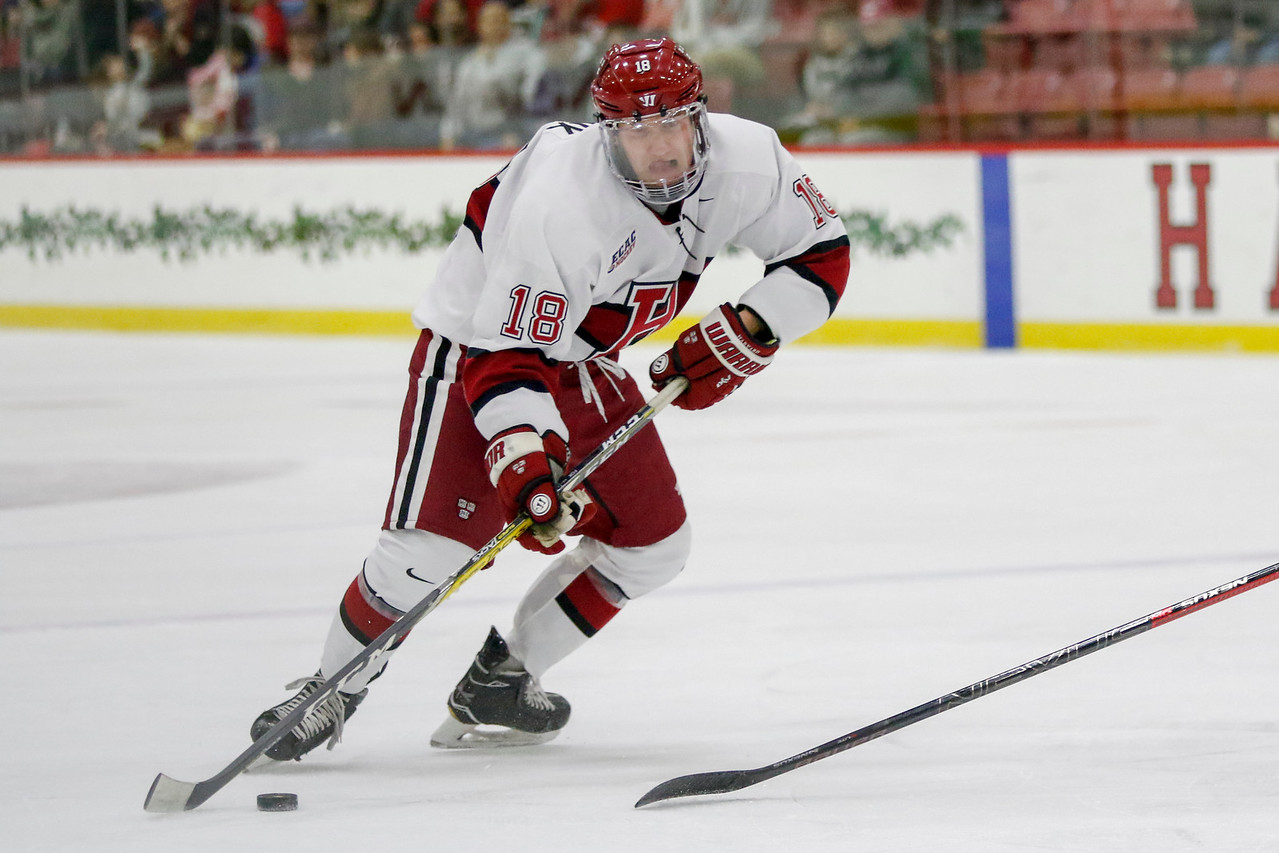
Both Fox and Marino saw their draft rights traded in the off-season, providing the opportunity for a more attractive NHL destination. Fox gets to don the sweater of his childhood team, while Marino joins a prestigious organization with a need for defensive depth. The two blue-liners are playing immediately with their organizations’ “big clubs.”
Despite the reality of occasionally bidding marquee players a premature farewell, a healthy representation of Crimson icemen in professional hockey is a positive for the Harvard program’s national relevance and future recruiting.
“I’m more concerned that they challenge themselves academically, that they are people of character...and take advantage of everything that a place like Harvard has to offer,” said coach Donato about players leaving early for the professional ranks. “If an opportunity comes for them to get started on their dream job, then in some ways they’re not all that different than another Harvard student.”
Fox’s and Marino’s on-ice contributions are easiest to focus on. But their graduation to the next level also has ramifications for the Crimson off the ice, particularly in the leadership department. In mid-April, the program named a trio of captains, which included both pivotal blue-liners, for the upcoming season. Now, only Nathan Krusko remains, and he will be the first sole letter-wearer Harvard has seen since Dan Ford ’14.
A major question of the Crimson’s 2019-2020 campaign, especially early on, is how the team will fill the voids left by these departures. Harvard must restock four of its top six defensemen, replace its leading goal-scorer from a year ago in Zerter-Gossage, and preserve an element of toughness in a rugged ECAC without Baughman, Marino, and Olson to dole out much of the physicality. Replacing Fox will necessarily be a team effort, and Floodstrand’s passionate leadership will be missed — though Krusko has impressed early on by embracing the position.
Notably, this challenge is all too familiar for coach Donato and his squad. With talented players joining and leaving the program each year, seemingly every preseason is subject to the same trope: “Will Harvard be able to replace its departures?” In recent memory, Hobey Baker winner Jimmy Vesey ’16 and two-time captain Kyle Criscuolo ’16 appeared difficult to replace; yet, the Crimson reached the Frozen Four in its first campaign without them. Last season was another indication that Harvard should be taken seriously regardless of who departs the program over the summer.
“[Losing players] just opens up opportunities for guys that are here,” coach Donato said. “It’s challenging from a team dynamic because there’s a lot of unknown, but it’s also exciting…. The challenge for us is to really show improvement throughout the year and try to get an identity.”
FRESH BLOOD
An influx of skilled freshmen was a primary factor allowing last year’s group to deal with — and even improve upon — the production lost to graduation and NHL departures over the summer.
For the 2019-2020 iteration of the Crimson, the story could very well be the same. Harvard welcomes seven first-years, many of whom will make the opening-night roster set to clash with Dartmouth.
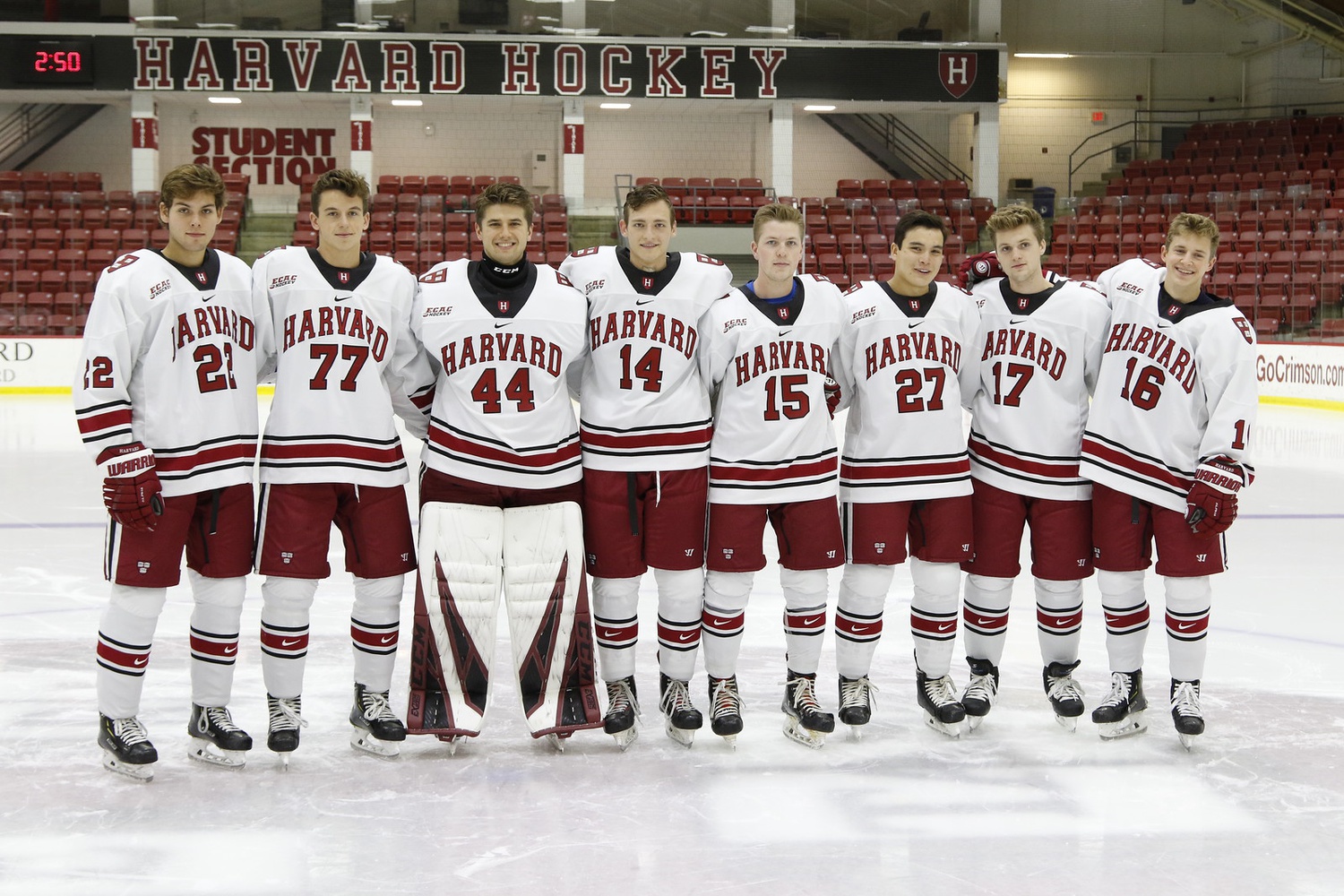
Up front, Slate Hill, N.Y. native Nick Abruzzese has been slotted into the top six. The Toronto Maple Leafs draft pick led the United States Hockey League in scoring last year (29–51—80) and has impressed in the preseason with his offensive touch and creativity. Abruzzese, a small but shifty winger, is shaping up to be a major contributor to the team’s production this season.
Fellow rookie forward John Farinacci, an Arizona Coyotes prospect, will also assume a large offensive role this year. Slotted on the wing in most preseason lines, he can provide versatility down the middle for coach Donato — his uncle — as a natural center.
“I think as a whole, the guys we brought in, we’re not going to have an issue...on offense. I think we'll score goals,” senior goaltender Cameron Gornet said. “Specifically for Farinacci and Abruzzese, I wish them the best of luck. I think they’re both great, and I think they’ll do really well this year.”
The third forward in the class of 2023 is also an NHL prospect. Austin Wong, a Winnipeg Jets selection in 2018, will add an element of two-way grit to a Crimson team that generally will be smaller and quicker than most ECAC groups. Due to injury, however, the team will have to wait on Wong’s contribution until sometime after the new year.
On the back end, Harvard returns just two of its top six skaters from one of college hockey’s most experienced blue lines in 2018-2019. So, freshmen will have the opportunity to play meaningful minutes right away.
One prime example is Henry Thrun, a left-shot, two-way defenseman and Anaheim Ducks selection. The U.S. National Team Development Program product is a logical fit with Walsh, the Crimson’s most seasoned rearguard and a right-shot, offensive-minded player.
Two other first-years should join Thrun in the top six this season. Southlake, Tex. native Jace Foskey and Madison, N.J. product Ryan Siedem will provide valuable right-hand shots to a blue line that lost two impact skaters on that side. Foskey sustained an injury in preseason practice and will not suit up on opening night, potentially thrusting Siedem into a top-four role as Foskey continues his recovery.
The seventh player rounding out the freshman class is goaltender Mitchell Gibson. A 2018 selection of the Washington Capitals, Gibson should at the very least provide healthy competition for Gornet and may even contend for starts this season.
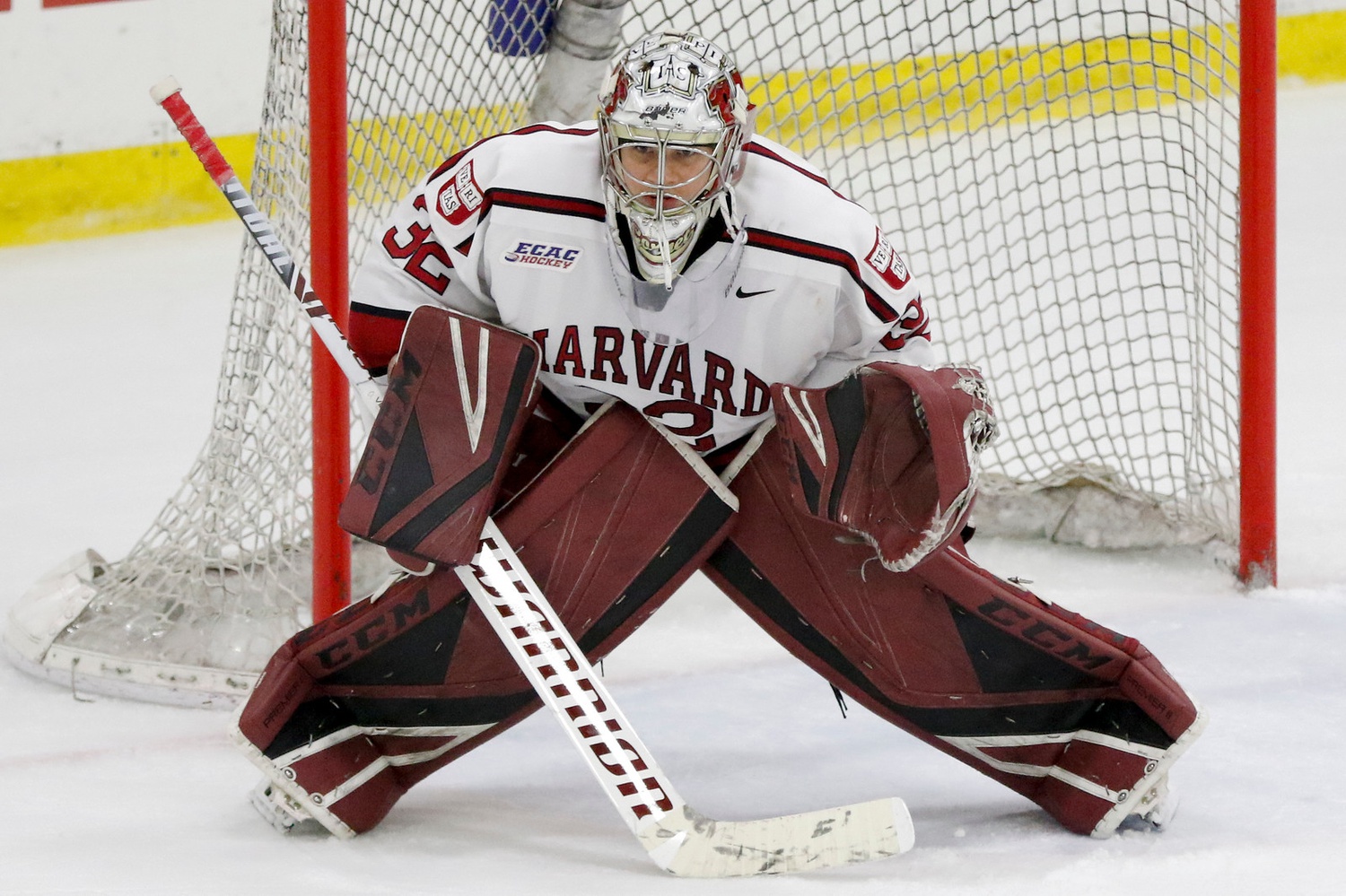
Gornet is the most senior returner in the crease and provided crucial net-minding (5-3-0, 2.56 GAA, .915 SV%) late last year during Harvard’s run to the NCAA Tournament. On top of these reasons, the St. Louis, Mo. native’s preseason has impressed enough that he will man the starting crease against the Big Green on Friday. That said, Gibson will vie for Gornet’s role throughout the year, making for an interesting goalie battle moving forward.
“We owe it to the team to have a competition for every spot, including the goaltending position,” coach Donato said. “Cam [Gornet] went in and played well last year and was certainly excited about the way he responded when he got his opportunity last year…. I do think Cam deserves the first opportunity to start against Dartmouth.”
STILL HERE
Of course, new additions are just one key element in the Crimson’s quest for success this season. Most Harvard icemen return to the team with added experience from the 2018-2019 run to the national tournament as well as a summer of training. Their progression, both on the ice and in the locker room, is as critical to the squad as the incoming talent.
The contributions of the class of 2022 marked a defining feature of last season’s success. Forwards Jack Drury and Casey Dornbach return as sophomores looking to set the tone offensively for the Crimson. Drury (9–15—26) blossomed as a leader and point-producer in his freshman campaign, as effective on the faceoff dot as he was on the powerplay.
Dornbach (7–22—29) entered his rookie year as more of a dark horse, not an NHL draft pick like his linemate Drury. That did not stop him from earning ECAC Rookie of the Year honors and a seat among the top five freshmen scorers in the NCAA. These two sophomores should anchor Harvard’s top forward trio for most of this season, and their early pairing with Abruzzese could form one of the ECAC’s most lethal lines.
“Both [Drury and Abruzzese] are special players, and we have some chemistry on the ice,” Dornbach said of his linemates days after an Oct. 19 exhibition at Dartmouth. “But our chemistry off [the ice], and our communication habits, are what are going to allow us to succeed when things aren’t going well…. I think we have a lot of potential, but now it’s time to put the work in.”
Juniors Henry Bowlby and Jack Badini were positive additions upon arrival two seasons ago and will be asked to take another step in terms of both leadership and production in 2019-2020. Last year, Bowlby (5–8—13) potted multiple big-time goals and demonstrated his ability to spark the offense. Badini (8–12—20) leveraged his speed and strength to put forth streaks of dominance as a sophomore but, like his classmate Bowlby, struggled with consistency.
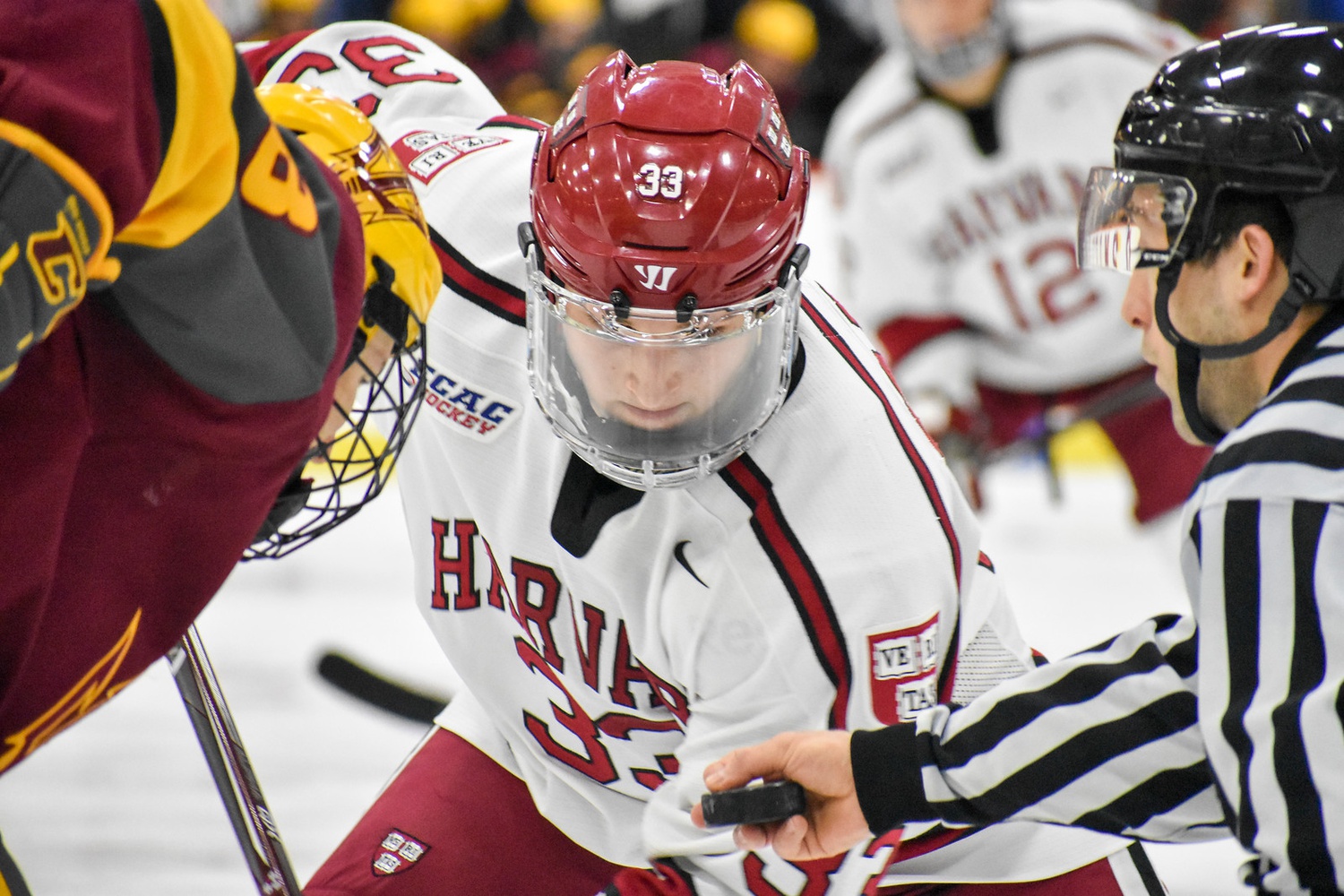
Badini commanded the circles last season, posting the second-best faceoff percentage in Division I (66.0%). He is a crucial piece in providing coach Donato with a surplus of effective options at center ice along with Drury, Farinacci, sophomore Baker Shore (2–11—13), and senior Frédéric Grégoire (6–9—15).
“We feel that good teams are built through the middle of the ice with good defense and good center icemen,” coach Donato said. “I think we have some of those pieces in place, but we’re going to have to really take a big step.”
Between these important pieces and the injection of multiple skilled freshmen up front, the upcoming campaign promises to feature a speedy Harvard attack which, while slightly undersized, has the potential to expose its share of goaltenders.
“We always love to play fast, and especially this year if you just look at our roster we have a lot of speed and skill,” Walsh said. “One critique you might have is our size, but...something we’re going to want to establish is getting pucks in, playing very hard, moving really fast, and making other teams’ bigger, slower players play to our speed.”
On the blue line, the progression of the two most experienced returners, Walsh and sophomore Jack Rathbone, is another major development to watch heading into 2019-2020, and its bearing on team success cannot be overstated.
Both defensemen are skilled puck movers and adept skaters who, after Fox and Marino departed early for the NHL, are going to see tougher defensive assignments and even more minutes this season. This additional workload could be especially pronounced early in the year, as expected top-six blue-liners heal and freshmen acclimate to the college game.
Through the first half of his NCAA career, Walsh has racked up 51 points (19–31—51) and garnered accolades such as a Third Team All-ECAC nomination and a spot on the ECAC All-Rookie Team. Last season (12–19—31), the New Jersey Devils prospect logged nearly a point per game (0.94) — good for eighth among NCAA defensemen — and played a vital role on the team’s powerplay, offering a potent slapshot from the point.
In 2018-2019, Rathbone put forth a promising first season in the crimson and white. The 2017 Vancouver Canucks selection (7–15—22) ranked third in the NCAA among first-year rearguards in points per game (0.67), and his performance earned him a conference all-freshman designation.
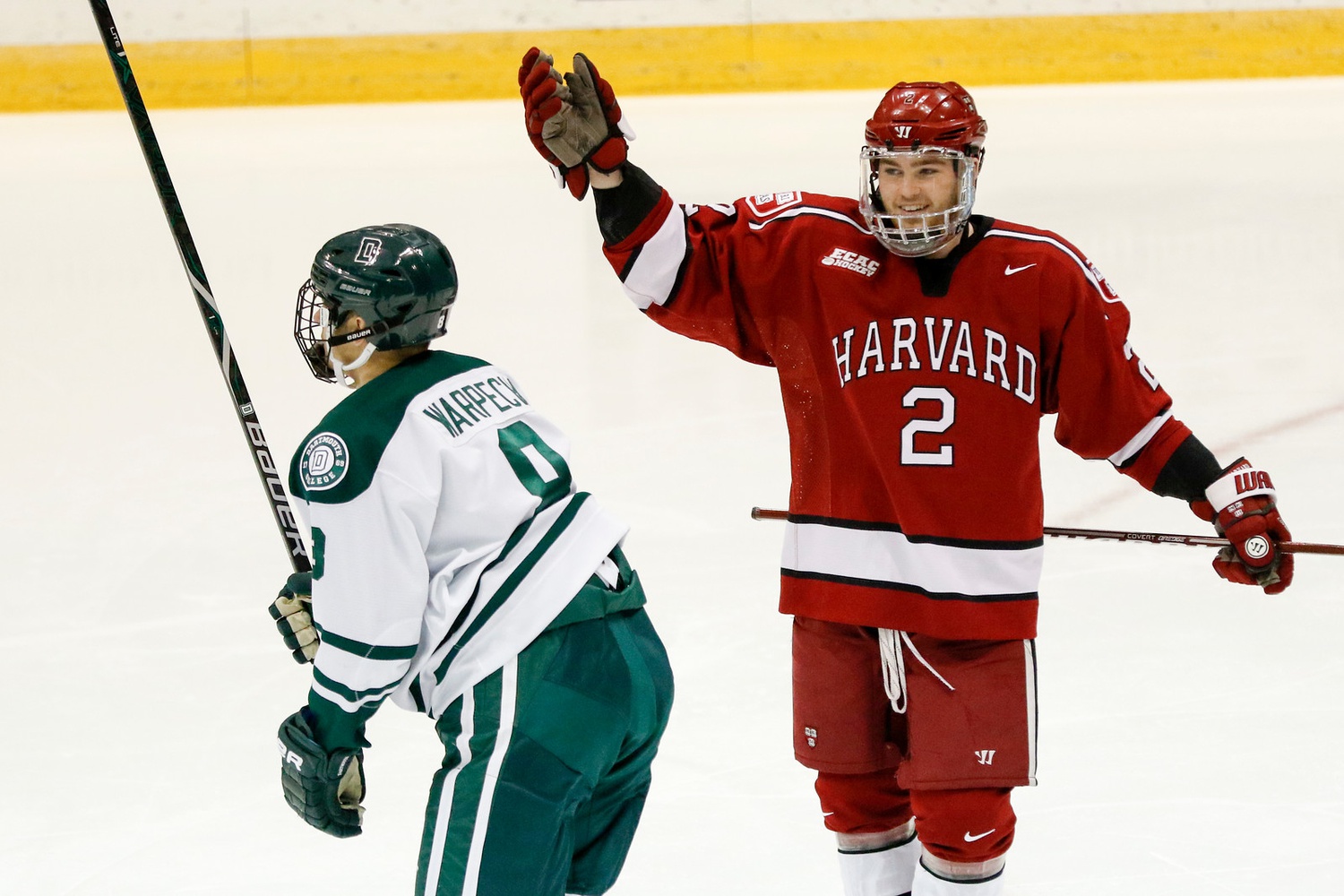
At even strength, coach Donato likely will task Walsh and Rathbone each with commanding his own pairing alongside a freshman as the team looks to address the defensive depth it lost over the summer. Sophomore Marshall Rifai, who went pointless in six appearances last season, is expected to round out the top six alongside first-years Thrun, Foskey, and Siedem when the blue line is at full health.
Thus, even with Walsh and Rathbone as elite ECAC defensemen, Harvard will ice four skaters with little to no collegiate experience on its back end this year. While center ice is an area of strength for the Crimson, the blue line has something to prove after high turnover from a season ago.
“We’re a young D corps coming in, with three freshmen coming into the blue line on the top six,” Walsh said. “But we’ve got a group that’s got a lot of USHL experience and guys that are very mature players even though they might be true freshmen…. I have to have a leadership role this year, taking those guys and giving them little pointers now and then.”
NEXT MAN UP ON MAN-UP
Harvard’s returning players will collectively address one pressing question mark for this year’s squad: the powerplay. In 2018-2019, the Crimson’s man advantage was the team’s most lethal element, cashing in nearly 30 percent of the time. Until the final weeks of the season, Harvard’s powerplay was consistently the top-rated unit in the NCAA.
A large part of this success was due to Fox, whose knack for man-up quarterbacking likely will never be surpassed in a Crimson uniform. Fox, along with Zerter-Gossage, will need to be replaced on this year’s first unit. And practically speaking, replicating last season’s 28.3 percent execution rate would be difficult for any powerplay.
Harvard still has potent pieces in place on the man advantage, as Drury, Dornbach, and Walsh will remain key components of the first unit. Rathbone is a logical piece to replace Fox at the point, and judging from preseason even-strength lines and the mid-October scrimmage against Dartmouth, Abruzzese probably will fill the final slot.
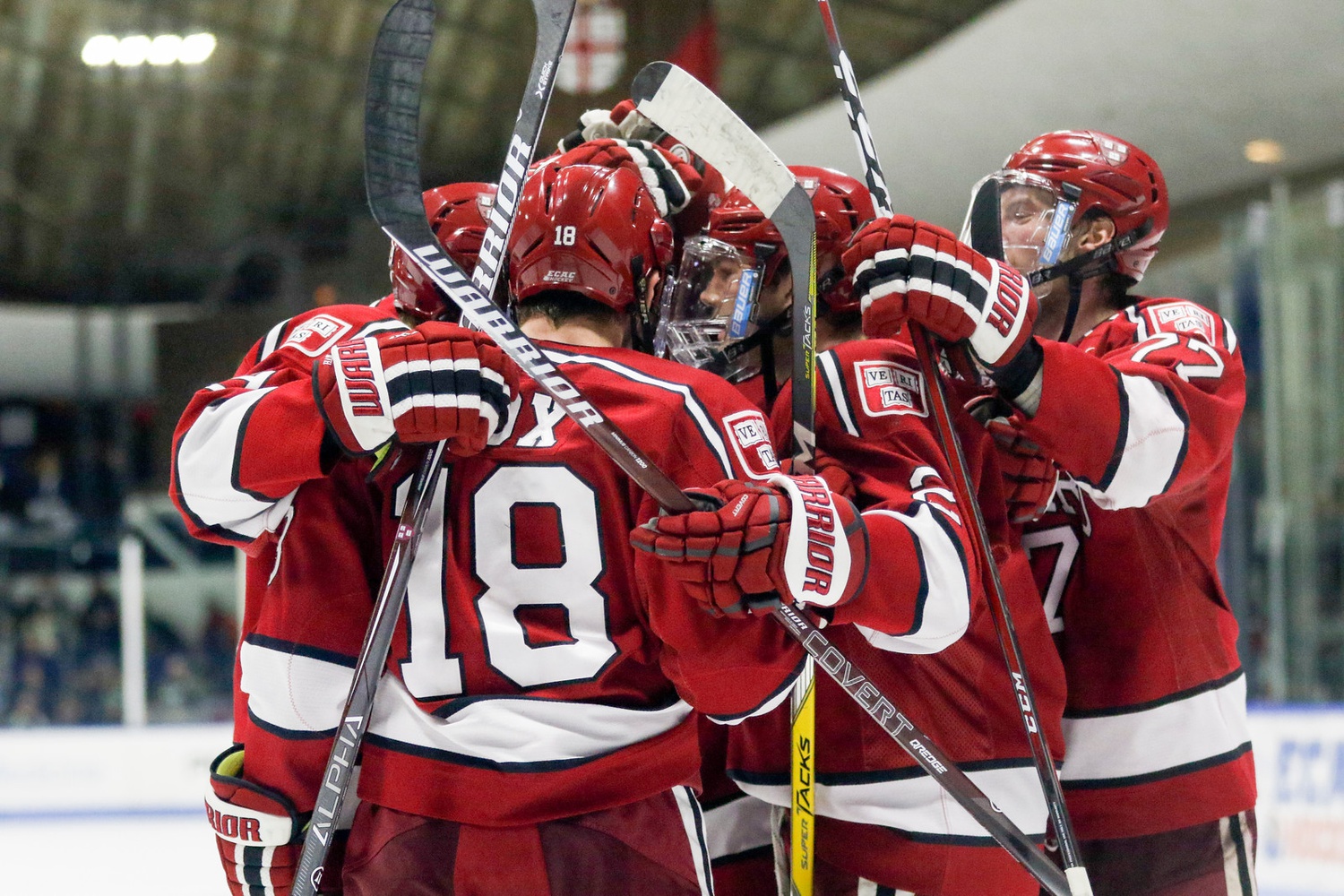
With several different pieces and a new face behind the bench in Assistant Coach James Marcou, the Crimson’s man-up attack will take a slightly different form. The willingness to share the puck evenly and often — a major improvement achieved by last year’s powerplay — surely will remain a point of emphasis. But in a new era for Harvard’s man advantage, consistent 5-on-5 play is all the more paramount.
“For the most part, they’ve been playing with each other for a long time,” said Bowlby about members of the powerplay unit. “It’s just kind of adjusting to maybe a lefty there versus a righty from last year and little things like that that won’t be too hard for them as they move forward.”
UPCOMING SLATE
The opening portion of the Crimson’s schedule is eerily similar to last year’s. The team battles Dartmouth to kick off the season, only this time it hosts rather than visits the Big Green. Then, the group welcomes Princeton and now-No. 9 Quinnipiac, travel partners who tripped to Cambridge on the second weekend of last season as well. A road weekend at Brown and Yale follows, also like 2018-2019.
This year, however, Harvard hopes to emerge from this similar start with a better record than last season’s 1-2-2. As in most other years, all five conference games are winnable due to the sheer parity found in the ECAC, though the Bobcats present the greatest challenge and most compelling measuring stick early on.
At the turn of December, the Crimson will battle two local blue chips from the Hockey East, now-No. 15 Boston College and Boston University. The pair of contests against historical Boston hockey juggernauts means that Harvard will face all three of its Beanpot rivals in 2019-2020, as it has drawn Northeastern on the first Monday of February’s annual tournament.
December is always a lighter month for the Crimson thanks to a three-week break for final exams and the holiday season, yet Harvard will have an eventful month nonetheless. Just three days after the meeting with the Terriers, coach Donato’s group will play host to now-No. 4/5 Cornell, an always formidable squad returning most key pieces from a year ago. The Crimson’s only victory over the Big Red in the past two seasons came in last year’s November turning-point game at Madison Square Garden, making Cornell one of Harvard’s most challenging foes in recent memory.
The Crimson wraps up the 2019 portion of the schedule after Christmas with a cross-country trip to Southern California, where it will faceoff twice against Arizona State at the Anaheim Ducks’ practice facility. Last season, the teams split their two-game series in Cambridge.
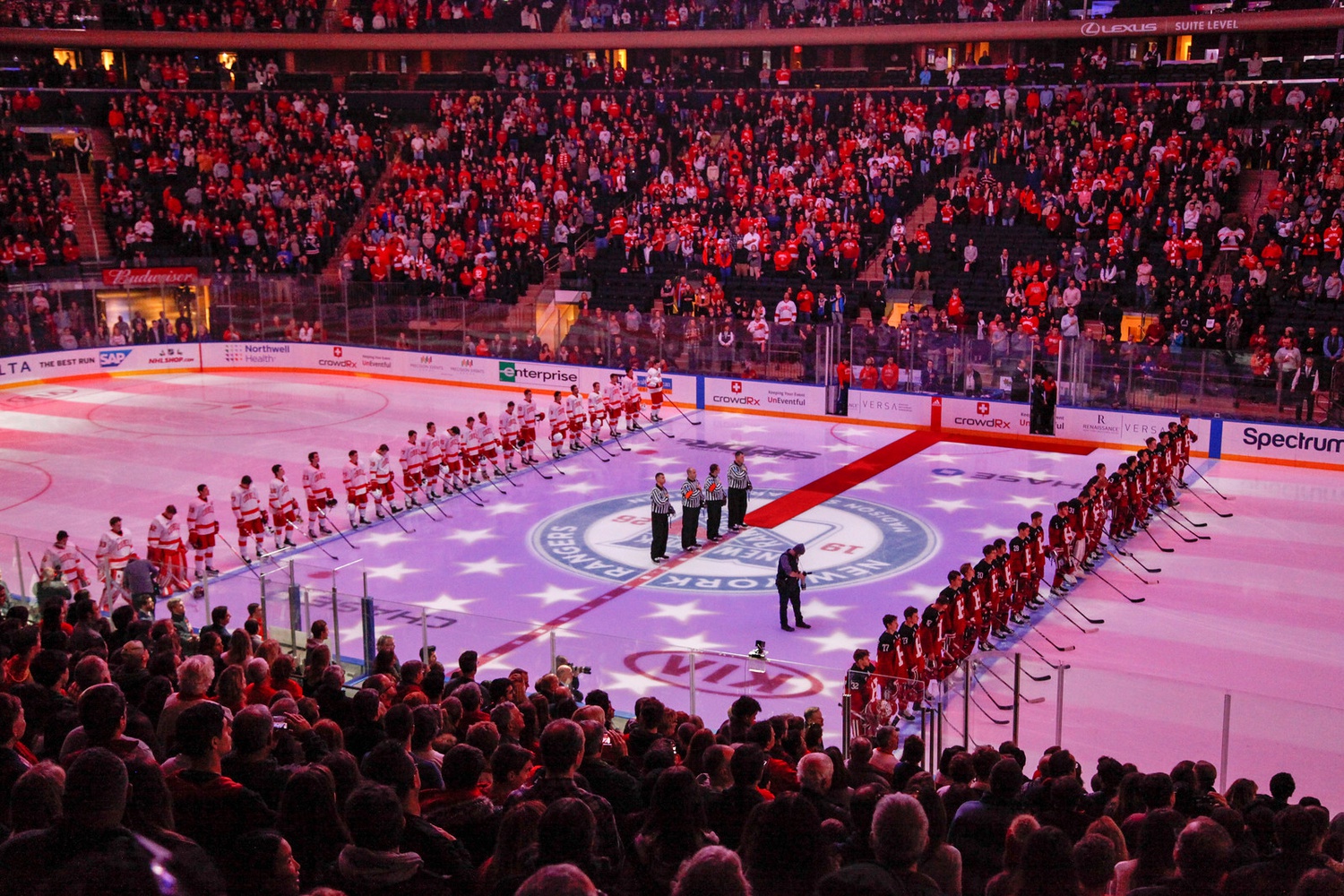
“We have our big games against BU and BC, and then we go to Anaheim. Those are all fun out-of-conference games,” Gornet said. “Every game is fun for me senior year, sort of my last hurrah. So I’m really looking forward to every game.”
After ringing in the new year, Harvard visits Quinnipiac for a second meeting before returning to Madison Square Garden after last January’s successful Frozen Apple outing for a marquee duel with Ivy League rival Yale.
In the back half of January, the Crimson hosts now-No. 11 Clarkson before making its annual trip to Cornell’s esteemed Lynah Rink, the source of one of college hockey’s most electric environments.
The Beanpot Tournament will, like always, demand most of the attention in the first half of February. Harvard takes on the now-No. 10 Huskies in the early game of the semifinal round, a chance to return to the tournament final the following Monday for the first time since winning the Beanpot in 2017.
Two home stands — the first featuring a visit from Yale and the second including a clash with Union — sandwich the infamous “North Country” road trip to Clarkson and St. Lawrence. These three weekends comprise the home stretch of the regular season before conference playoffs commence in early March. As always, the Crimson will be targeting a top-four finish in the ECAC to earn a first-round bye in the conference tournament.
Overall, Harvard’s 2019-2020 season will present mostly familiar challenges — replacing talented departures, integrating skilled freshmen, and battling through an ECAC characterized by parity, to name a few. This year, however, an especially young core will be given the responsibility of carrying the Crimson, making for a campaign of exciting hockey and, undoubtedly, lessons learned along the way.
—Staff writer Spencer R. Morris can be reached at spencer.morris@thecrimson.com. Follow him on Twitter @SMorrisTHC.
